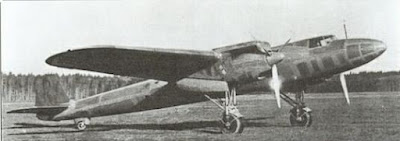The Dornier Do 17 was a German light bomber used by the Luftwaffe during World War II. It was also used as a night fighter and reconnaissance aircraft. Due to the elongated and slender fuselage of the first variant, it was known as the 'flying pencil'. A total of 2,139 aircraft were manufactured in different versions, taking part in every theater of operation of WW2. The Do 215 would be developed from this warplane.
The Dornier Do 17 had originally been designed as a commercial aircraft; a high-speed mail plane capable of carrying six passengers. Under this guise, the first prototype, the Do 17 V1, performed its maiden flight on November 23, 1934. It was passed over to Lufthansa for evaluation, along with the second and third prototypes, which were fitted with two BMW V1 7.3, 12-cylinder engines, each delivering 750-HP. However, the Lufthansa test pilot saw it had potential as a bomber and communicated this to the air ministry.
The first production model was the Dornier Do 17E-1, a bomber, which was built alongside the almost identical Do 17F-1, which was a dedicated long-range reconnaissance aircraft. These two versions entered service with the Luftwaffe in 1937. The Do 17E-1 could carry up to 750-kg (1,650-lb) of bombs (one 500-kg and one 250-kg bomb), while the 17F-1 carried a pair of cameras for its reconnaissance missions. They would both be sent to Spain, with the Condor Legion, to take part in the civil war.
Below, the Do 17E-1 in flight in 1938.
The Dornier Do 17M and Do 17P were developed as replacements for the 17E-1 and 17F-1 respectively. The 17M bomber variant was powered by two Bramo 323A-1, Fafnir, 9-cylinder, air-cooled radial engines, which produced 950 horsepower each. Meanwhile, the reconnaissance version, the 17P, was equipped with two 865-HP, BMW 132N engines. These variants would see combat action in September 1939, during the German invasion of Poland.
Technical Description
The Dornier Do 17 was a two-engine monoplane. It was fitted with straight, cantilever shoulder wing and retractable landing gear.
Specifications (Do 17Z-2)
Type: light bomber
Length: 15.79 m (51 feet, 9 inches)
Wing Span: 18 m (59 feet)
Wing Area: 55 m2 (592 sq. feet)
Height: 4.56 m (14 feet, 11 inches)
Power Plant: two BMW Bramo 323P, Fafnir, 9-cylinder radial engines, each developing 1,000 HP.
Maximum Speed: 410 km/h (255 mph)
Range: 1,160 km (720 miles)
Ceiling: 7,000 m (22,750 feet)
Armament: two forward-firing 7.92-mm MG-15 machine guns; two 7.92-mm machine guns firing from side windows; and one 7.92mm firing aft from a ventral position. It carried up to 1,000-kg of bombs, or two 500-kg of bombs.
Below, the Dornier Do 17 V1, the "flying pencil".
The 17P-1 variant in late 1937.
The Do 17Z-2 version in the Summer of 1941, right before Operation Barbarossa was set in motion.
Below, the Do 17Z-1 on the Eastern Front.
Two bombers on their way to Poland in September 1939.








